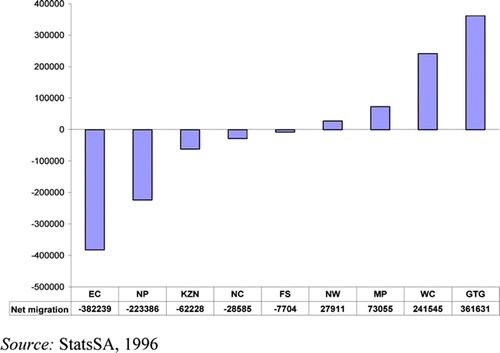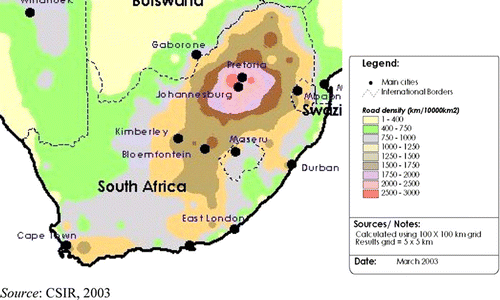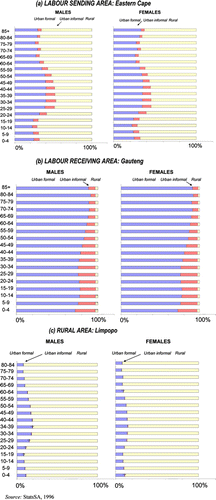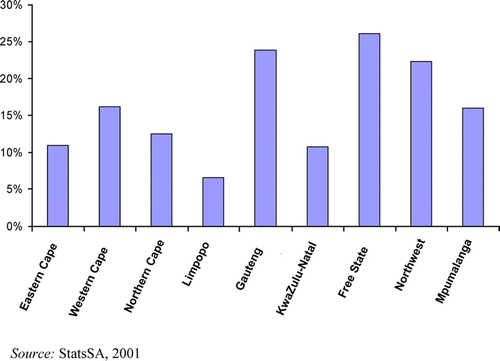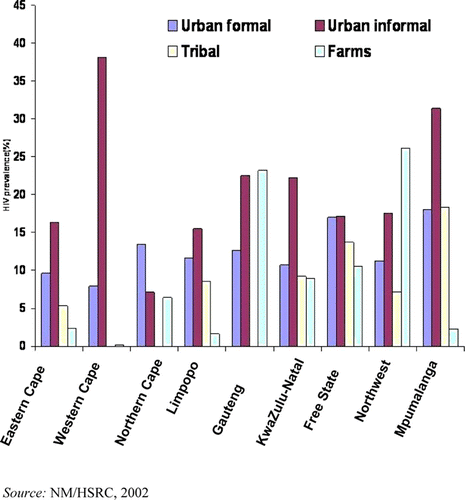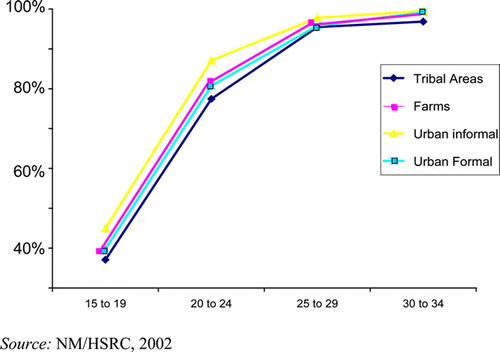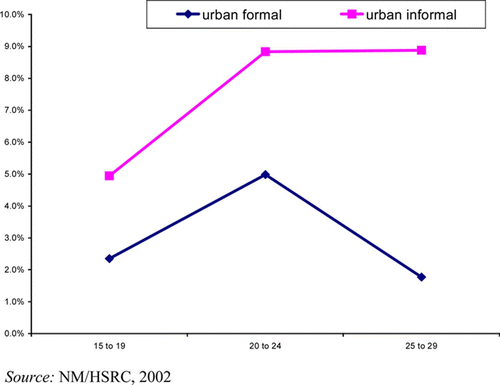Abstract
The demography of both urban and rural South Africa is shaped by migration, with three unique patterns: labour-sending, labour-receiving and rural areas. This article explores the relationship between HIV risk and migration in South Africa. It identifies the urban informal settlements common in labour-receiving areas as key magnifiers of HIV risk, increasing the vulnerability of migrant workers in these townships. It examines the urban informal settlement, a unique social environment with distinctly high-risk behaviour dynamics, as a focal determinant of HIV. It proposes this framework as an extension of the migration–HIV dialectic beyond the traditionally unidimensional approach, to encompass a more contextualised discussion. This methodology, which uses the environment as an entry point to understanding behaviour and emphasises the importance of addressing the HIV–migration issue within a broader development perspective, has important implications for HIV programming in South Africa.
1. INTRODUCTION
Migration is a fundamental part of the architecture of modern-day South Africa, shaping many social and cultural practices. Unfortunately, the history and geography of migration in South Africa have been characterised by intractably complex problems, compounded by poverty, inequality and HIV/AIDS. The vulnerabilities of migrant living are exacerbated by poverty and transience, and key decisions on sexual health practices are rooted in complex social–environmental contexts.
The impact of migration on the AIDS epidemic in sub-Saharan Africa and indeed worldwide remains woefully under-evaluated. Migration is a poorly understood phenomenon, evading characterisation and meaningful measurement. Efforts to capture migrant behaviour through survey methodology do not effectively capture its dynamism. Population-based surveys typically exclude those living in hostels, and where they attempt to ascertain the impact of migration on the household fall short of adequate definitions. Additionally, substandard measurement techniques have thwarted attempts to capture health risks in migrant communities and limited the scope of quantitative analyses.
Assessing the impact of migration as a contributor to ill health is problematic, in part because there are many confounders related to both mobility and health status, including a variety of economic variables such as poverty and income distribution, and in part because of differences in the behavioural characteristics of migrant communities. As a result, it is prudent to remember that a multitude of confounding factors can influence such links. Global links between migration and HIV/AIDS are, however, clear. In areas of the world where populations are mobile, there are clear trends towards the spread of disease.
Ecological analyses also provide insight into associations and suggest possible proximal determinants of HIV risk. A comparative study (Boerma et al., Citation2002; Boerma et al., undated) of relatively high and low level prevalence areas in Kisesa, Tanzania and Manicaland, Zimbabwe, identifies mobility as a potential risk factor for the uneven spread of HIV in rural areas. In Kisesa, prevalence among men aged 17–44 and women 15–44 was 5.3 per cent and 8 per cent, respectively, while in Manicaland these values were more than three times higher: 15.4 per cent and 21.1 per cent, respectively. In the low mobility area of Kisesa, 0.8 per cent of husbands and 1.6 per cent of wives were not cohabiting with their spouses, while in the high-mobility areas of Manicaland the corresponding values were 10.8 per cent and 52.9 per cent. Recent in-migration was a significant risk factor for HIV at both sites, and in Kisesa those who had moved into the ward had a higher HIV prevalence than those who had been resident in the ward all their lives. Additionally, HIV prevalence was twice as high in the trading centres as in the surrounding areas. The authors suggest that higher levels of mobility and spousal separation in Manicaland may have led to greater contact with high-risk groups. Another recent study (Lagarde et al., Citation2003), conducted in West Africa where the epidemic is more attenuated than in southern Africa, shows the impact of mobility on epidemic spread. A comparison of rural communities in Senegal and Guinea-Bissau showed that mobility was a key factor for HIV spread in rural areas, in part because population movement allowed the spread of HIV, but also because of the particularly risky behaviours of mobile communities. Short-term mobility was found to be a risk factor for HIV, with male migrants being twice as likely to be infected as non-migrants.
This article explores the relationship between HIV risk and migration in South Africa by identifying urban informal settlements as key magnifiers of risk, increasing the vulnerability of migrants to HIV. It makes a concerted attempt to look beyond the oft-cited unidimensional relationship between HIV and migration, and begins to contextualise the problem into the unique environments in which migrants live, exploring the urban informal settlement as a focal determinant of HIV risk (Banati, Citation2005). This approach allows a reconfiguration of the migration–HIV dialectic by ensuring a contextualisation of the HIV/AIDS problem within a broader discussion and provides a better understanding of the determinants of HIV infection in migrant communities. HIV programmatic interventions can be vastly improved when a holistic picture can be presented. To date, however, these have been typically vertical in nature. In identifying the multidimensionality of HIV risk, this study presents solutions that may fall outside traditional programmatic interventions and present novel solutions that have not been evaluated to date.
The next section of the article reviews the migration dynamic in South Africa from both historical and geographic perspectives. This is followed by a description of urban informal settlements as risk amplifiers, defining these areas as focal determinants of HIV risk in the South African context. This involves a discussion of the unique risk environments generated among migrant communities living in urban informal areas, with an exploration of high-risk sexual behaviours commonly seen in these geotypes. In conclusion, the implications for HIV programming are presented, with a view to addressing the migration–HIV dynamic within a broader development perspective.
2. PERSPECTIVES ON MIGRATION AND HIV/AIDS
A cursory review of countries and their corresponding migration indices shows the association of migration and high HIV prevalence. This can be seen for the southern African region in . Small countries with highly mobile populations where disease spread is less contained, such as Swaziland and Lesotho, have experienced a faster growth in the epidemic, evidenced by smaller time intervals between the year that widespread HIV transmission began and the year peak HIV incidence was noted. It is possible that population mobility may have contributed to the speed at which peak incidence was reached (UNDP, Citation2003) and shaped the nature of the epidemic.
Table 1. Migration, HIV prevalence and behaviours in the southern African region
In Central and West Africa, HIV-1 seroprevalence rates are considerably higher in urban centres than rural areas, with urban rates typically four to ten times higher than rural (Caldwell & Okonjo, Citation1968; Quinn, Citation1994). Rapid urbanisation in African cities has been linked to urban poverty and unemployment and there are additional social and economic pressures on those living in the mushrooming urban slums (Buve et al., Citation2002). It is important to understand that the communities in these informal areas are typically transient. This study accepts the well-founded assumption that informal housing arises from the needs of mobile communities: informal settlements indicate migrant populations. The social constructions of these areas are uniquely high-risk, with distinct behavioural dynamics, and differing sexual behaviours are an important consideration in understanding these dynamics. Commercial sex is more prevalent in urban centres, where bright lights and temptation can attract and anonymity is secured (Jochelson et al., Citation1991). Additionally, migrants to urban centres belong to different sexual networks from rural people (Weir et al., Citation2003). Urban migration patterns are often associated with an increase in risky sexual behaviours, particularly increased partnership rates (Coffee et al., Citation2005) and a higher rate of sex outside of marriage (Herdt, Citation1997). Urbanisation increases opportunities for sexual encounters, and urban residents tend to marry later and have a greater frequency of casual sexual relationships as a result.
Beyond existing differences in sexual relationships, the social and cultural milieu of one's immediate environment affects health risks. Stereotypical dichotomies of ‘urbanisation, individualism and modernity’ vs ‘village, community and tradition’ have been identified as important factors in determining migrant interactions in the urban environment (Crush, Citation1997). Adaptation is imperative to ensure successful migration and, as a result, changes in cultural practices, including the acceptance of sexual freedoms in urban areas, are a necessary consequence. Epidemic conditions can also arise from the ‘notion of “crisis”, of social disintegration’, where ‘critical events’ can provide suitable conditions for intensified spread of HIV (Herdt, Citation1997). War conditions in central Africa are oft-cited examples and, in the case of South Africa, the end of apartheid gave rise to massive population movement and social upheaval in a previously subjugated society, creating substantial disruptions and possibly contributing to the spread of disease.
While simple geographic distinctions provide an important explanatory variable in the assessment of health risk, the vulnerabilities of migrant lifestyles and their relationship to health are complicated. Heavy migrant flows, increases in female migration, highly evolved transport infrastructure and rapid urbanisation have blurred the geographic distinction with respect to health end-points, and what can be construed about the relationship between migration and health in South Africa is limited. As a consequence, a better-resolved geographical representation is warranted. At the magisterial district level, 1996 South African Census data provide insights into migration patterns at an earlier stage of the epidemic. shows the weighted distribution of the proportion of people having lived in their usual place of residence for less than two years. The pattern reflects centres where population dynamics are transient, focused in the goldmining areas of Gauteng and the Northwest, west of Johannesburg centre. Of interest is the coast of KwaZulu-Natal north of Durban, which shows a higher proportion of people reporting having lived in their usual place of residence for less than two years. Additionally, pockets of Limpopo Province, where platinum mining occurs, are also brought to attention.
Figure 1. Weighted distribution of respondents having lived less than two years in usual place of residence

shows the provincial distribution of net migrant flow in the mid-1990s. Gauteng had the highest migrant flow, while the Eastern Cape had the largest out-flux of migrant workers. Net gains and losses, however, do not convey circular migration patterns. The Northwest Province showed only a small net increase in migrant workers entering the province, but it is likely that large-scale circular migration between the mines and the rural homelands is not fully captured. The schematic representation in shows the direction of inter-province migration flows. Light grey arrows indicate the source locations of the largest number of immigrants into each province; dark grey arrows indicate the second and third largest source provinces. This figure displays the complexity of interprovincial migration, but also identifies Gauteng as a primary destination for many intraprovincial migrants. In most cases the primary migrant flows remains intraprovincial. Other types of migration form a small component of overall movement and in fact much more mobility occurs within provinces and from nearby settlements (Stevens & Rule, undated). However, international migration cannot be discounted as a vector of disease and the introduction of foreign migrants into local sexual networks may have played a part in spreading HIV initially.
Figure 3. Map of inter-province migration (light grey denotes primary flow, dark grey denotes secondary flow)
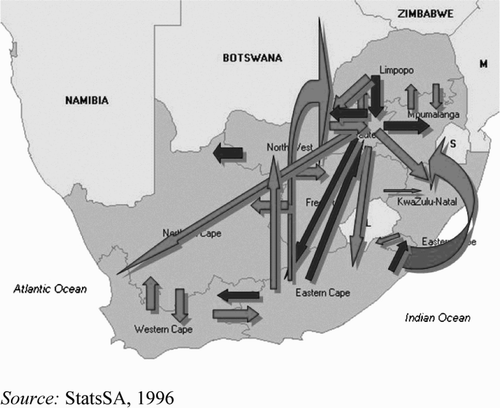
shows the distribution of types of areas from which migrants come. Values shown on bold type identify the primary type of previous residence among women responding to the South African Demographic and Health Survey (SADHS, Citation1998). Among migrant women, most previously lived in the countryside, while in Gauteng most moved between (or more likely within) cities and those in the Western and Northern Cape had previous residences in urban areas. reflects a type of hierarchy consistent with rural to urban migration, showing that much movement appears to be occurring away from rural areas, into towns and cities. An important note here is that many migrants reaching highly urbanised areas such as Gauteng or the Western Cape (and the large cities of Johannesburg and Cape Town) tend to move within or between these cities.
Table 2. Previous place of residence among women not living in their usual place of residence
The distribution of migrant flows is a function of the existence of transport networks, and the capacity to carry human traffic can limit or promote migrant labour. The role of the transport industry in the AIDS epidemic in South Africa has been previously documented. While effective transport and access are prerequisites for economic growth and development, the spread of disease that occurs may consequently annul some of its positive attributes. Whiteside Citation(1998) notes that South Africa has the greatest concentration of roads and railways, the greatest number of vehicles in southern Africa and the busiest air traffic in Africa. It is important to recognise the impact of the flourishing transport industry on health outcomes. shows the distribution of road density per 10 000 km in southern Africa (CSIR, 2003). It is evident that Gauteng and the western periphery of Johannesburg have the greatest density, and much of this infrastructure is designed around industrial centres. This can be a useful contribution to understanding spatial variations in risk, but there are limitations, including the inability of road density to reflect frequency of transport use or numbers of passengers. In the less affluent parts of the country, the ratio of passengers to driver may be many multiples compared to that of more affluent areas. However, despite these provisos, such a distribution provides a reasonable insight into the dynamics of population movement.
In sum, Gauteng is a province receiving many migrants, as evidenced by the density of population who have lived there for relatively short periods and by existing migration pathways. It is also a province with a higher density of urban informal areas than labour-sending areas such as the Eastern Cape. As the following sections describe, urban informal areas are a unique geographic, social and cultural context for migrants, engendering high-risk environments for this particularly vulnerable group.
3. URBAN INFORMAL AREAS IN SOUTH AFRICA
The distribution of urban and rural proportions of the population in selected provinces, by age and gender, can be seen in . The first pattern, as evidenced by the Eastern Cape Province, is where men and women in their 20s travel to urban areas in search of employment (. Upon their arrival, many take up residence in informal settlements on the periphery of the city. The average 20–24-year-old male is twice as likely to live in an informal settlement in a labour-receiving province such as Gauteng as in a labour-sending province like the Eastern Cape. As they grow older, some return to rural areas while some move to more formal urban areas. The demographic bulge of those aged 20–50 living in urban areas clearly reflects this pattern. Similar patterns are seen in KwaZulu-Natal and Mpumalanga. In the second pattern, as evidenced by Gauteng, the pattern is reversed, and rural living forms a very small proportion (. The largest proportions of all age groups live in urban areas, with a considerable proportion of those migrating from outside Gauteng living in urban informal areas. Those under 50 are more likely to live in urban informal areas than those who are older. The demographic bulge seen in urban areas among those aged 20–50 is not apparent here. The third pattern occurs in areas such as Limpopo Province (. These areas do not have a very high migrant population and, as a result, tend to have largely rural settlements, with an almost complete absence of informal areas.
The geotype profile of the population thus differs significantly by province. Labour-intensive provinces have a larger proportion of people living in urban areas in general and more specifically in urban informal areas. The majority of provinces display the common pattern of urban migration to the cities among those in their productive years, reflected by a demographic bulge among those aged 15–49 living in urban formal and informal areas. This mainly reflects intraprovincial migration, which is the largest migratory pathway in South Africa. Ironically, this route has been largely ignored in the research arena, in favour of interprovince and international migration, which occurs on a comparatively smaller scale. Research on longer migratory pathways have yielded very interesting results (Lurie et al., Citation2003). However, people working in the nearest local city are the more common migrant workers, and their characteristics and behaviours differ significantly from long-distance circular migrants, particularly in the frequency of home visits.
Provinces unable to accommodate a vast influx of rural migrants into urban areas have seen an upsurge of urban informal settlements, most notably in the Free State, Gauteng and Northwest provinces, where the largest proportion of urban informal residents live (). Urban informal areas are characterised by poor housing structures, with limited sanitation provision and limited access to health care and other resources. Informal areas vary considerably, from poorly constructed cardboard housing structures without running water or access to sanitation, to elaborately constructed brick dwellings with amenities comparable to many formal areas. The transitory nature of the informal settlement precludes the formation of the socially cohesive structures which are often associated with improved health measures (Campbell et al., Citation2002).
Gauteng, the province that is home to the largest number of migrant workers in South Africa, has seen a large growth in informal settlements. In 1998, 180 informal settlements were identified in Gauteng, housing in excess of an estimated one million people. Many are unemployed youth, seeking independence from their families and hoping to find work in urban centres and access services not routinely available in rural areas (Stevens & Rule, undated).
4. URBAN INFORMAL AREAS AS RISK AMPLIFIERS
HIV prevalence in South Africa is notably higher in urban informal areas. The 2002 NM/HSRC study of HIV/AIDS shows that while there is no difference between HIV prevalence in formal urban areas and rural areas, startling differences do exist between formal and informal urban areas. identifies these differences. HIV prevalence in urban informal areas is more than twice that of urban formal areas in South Africa, and among 15–49-year-olds is alarmingly high at 28.4 per cent, reflecting a 40 per cent increased risk among youth in urban informal areas compared to those in urban formal areas when correcting for behavioural variables (NM/HSRC, 2002). In nearly every province, informal urban areas present the highest HIV prevalence rates, confirming the important contribution of this geotype to increased health risks (). Urban informal living is identified in this analysis as a high-risk focus area and, while HIV risk remains high for this geotype in all provinces, there is a clear need for specific interventions in provinces such as the Northwest, the Free State and Gauteng, which have high HIV prevalence rates and high densities of urban informal settlements.
Table 3. HIV prevalence by geotype
Residence type is therefore a strong predictor of behavioural risk. Results from the recent NM/HSRC (2002) study clearly show an increased vulnerability to high-risk sexual behaviours among those living in urban informal areas, compared to their counterparts in urban formal or rural areas. This type of analysis is unique, as matched quantitative data of sexual behaviours allowing for geographical stratification has not been available prior to this study. While qualitative information about risk behaviours in urban townships is present in the literature, inferring health risks from this information has had limited success. It is evident from and the NM/HSRC data that, among both males and females, a greater proportion of residents of urban informal areas tend to have more than one partner (). Sexual experience also differed significantly by geotype. Among 15–24-year-olds living in informal urban areas, 74 per cent were sexually active compared to 53 per cent among their urban formal counterparts (). The higher curve seen in informal settlements reflects the higher degree of pressure for sexual encounters among young people living in these environments.
The age distribution of those with more than one partner is shown by geotype in . The decrease in those with multiple partners in the 25–29-year age groups represents the increase in marriage rates in that age group. However, in urban informal areas, casual relationships persist into adulthood and such a decline is seen later than in urban formal areas, possibly reflecting the higher proportion of migrants in urban informal areas.
A recent study (Weir et al., Citation2003) confirms the importance of large sexual networks as drivers of the HIV epidemic in township settings, in contrast to the commercial sex industry which is typically held responsible for propagating HIV. Sexual networks are important to this discussion as they present defined risk behaviours in distinct locales, and they link locales to the accelerated spread of infection geographically. In the South African townships investigated, over a quarter of men and women had a new sexual partner within the previous four weeks, with fewer than 10 per cent of women acknowledging an exchange of cash for sex. As a result, commercial sex was considered to be only a small proportion of new relationships formed in townships. The rate of new partnerships among women in townships was of an order of magnitude higher than that reported in household surveys, suggesting differing patterns of sexual behaviour in urban informal settings. High-risk environments also present with greater risk avoidance strategies. Encouragingly, condom use rates are higher in urban informal areas than in urban formal areas, most notably among females, where 23.6 per cent used a condom at last sex in formal urban areas, compared with 37.2 per cent in informal areas (NM/HSRC, 2002).
In modern-day South Africa, urban informal living is characterised by a volatile mix of transience, high crime rates, high unemployment and poverty, resulting in risky sexual behavioural dynamics.
Migration plays a pivotal role in defining vulnerabilities in the contracting of disease as well as determining patterns of disease transmission – what Anarfi terms the ‘double dynamic relationship’ between migration and HIV/AIDS (Anarfi, Citation2005). The nature of urban informal residence uniquely exemplifies this double dynamic. These areas have a higher HIV prevalence than other geotypes, thus increasing the likelihood that new migrants will contract HIV, and they also engender risky sexual behaviours, thus promoting increased HIV transmission. Low social cohesion and high crime rates, and gender, income and racial inequalities, combined with poor access to information and poor perceptions of self-determinism, are pervasive in urban informal areas and build upon the migrants' disengagement from existing social support mechanisms and their insecurity in new surroundings to amplify the already high vulnerabilities of migrant living.
This can be exemplified through a typical case. Nthabiseng (not her real name) is a young, unmarried, informally employed African female living in an informal urban area. Nthabiseng has recently moved from the rural Eastern Cape to an informal urban area south of Johannesburg. She has two young children, who live with her mother in the Eastern Cape. She came seeking employment, hoping to send money back home. When she first arrived, she stayed with her uncle and his second wife, but when she wanted to open a fruit stand on their plot they evicted her from the property. She then rented a shack in her uncle's employer's back yard for R150 a month and began to wash clothes to earn some money. Struggling to pay her rent, she agreed to her landlord's proposition for sexual favours. The subsequent rental subsidy and her ability to find a job as a part-time domestic worker in the northern suburbs have allowed her to save about R100 a month which she sends home to her children. In the meanwhile, she is inundated by HIV/AIDS messaging encouraging condom use, faithfulness, counselling and testing. Suggesting condom use to her partner resulted in a fierce quarrel and he threatened to remove her from the plot – he says he is not infected, citing his current fitness levels in support. Also, he has three children from his first wife and two from his second wife – how can an infected man be so virile? She will not ask again, although she sees him at the shebeen with his girlfriends, and sometimes he brings them to his house, but she is not sure what she can do about it. In any case, at least she manages to provide some money to her family through this arrangement.
Unfortunately, Nthabiseng's predicament is all too common among informal urban residents in South Africa. Her current living arrangements, uncertain lifestyle and lack of social support mechanisms have caused her to engage in high-risk behaviours. The sexual disempowerment she experiences is a direct function of her lack of autonomy. For Nthabiseng, interventions seeking to change her behaviour in order to decrease her risk of HIV take two forms. The first is individual intervention aimed at influencing proximal determinants of behaviour, such as helping her negotiate condom use in the context of her disempowered relationship with her sexual partner. The second is societal intervention, addressing more distal determinants of behaviour, such as working to alleviate poverty so that she no longer needs to compromise in her relationship with her landlord – or, indeed, to migrate to begin with. However, unless these interventions take into account her environment and the impact of migrancy on her lifestyle choices, neither is likely to be successful. The example of Nthabiseng suggests that efforts aimed exclusively at individual agency or societal structure are unlikely to be successful, as they do not capture the daily contexts in which people live. What is needed is a new approach to understanding behaviour and ways in which HIV risk can be mitigated that reconcile this dichotomy. Programmatic interventions using the focal determinants approach (Banati, Citation2005) use the contextual environment as the entry point to understanding behaviour.
5. FOCAL DETERMINANTS APPROACH
If programmatic interventions are to help migrants, they need to be contextualised. Those that deal specifically with urban informal areas can be successful with this high-risk group. Typically, micro-agency or macro-structural interventions have worked independently of each other, but interventions based on the focal determinants approach automatically reconcile both micro and macro approaches. In South Africa the urban informal environment is a specific locale where risk is amplified and forms a focal determinant of considerable significance. An intervention based on an understanding of not only individual behavioural limitations but also the dynamics of urban informal living can facilitate behaviour change. Social insecurity is a key concern for many of the residents in urban informal settlements, so interventions aimed at alleviating this insecurity may attenuate the high levels of risk generated in these specific contexts. Such interventions could take the form of promoting social cohesion among community members and addressing disillusionment.
The focal determinants framework (Banati, Citation2005) is a useful way to describe the amplification of HIV risk among migrant communities by considering the urban informal environment as a special determinant that cuts across all levels, from macro to micro (as shown in ). This approach reconciles the current polarisation of macro–micro approaches to HIV interventions and incorporates a third dimension to understanding behavioural environments. It defines environments as explicit determinants affecting behavioural dynamics, by reviewing the environments (through physical spaces) within which people operate, and by encompassing the macro and micro contexts of people's lives. The urban informal context is a distinct high-risk environment, characterised by high unemployment, disillusionment, poor housing, female disempowerment, reduced access to health care, low economy and a lack of social cohesion. All these factors, which interplay to amplify the risks for migrants, make urban informal areas focal determinants of risk.
Focal determinants, as they amplify risk, also allow for unique risk mitigation strategies, in the form of socially acceptable and available solutions to the high-risk environments experienced in these areas. For males in informal urban settlements, data suggests that condom use is generally an acceptable and widely used protective measure (NM/HSRC, Citation2005). This offers an opportunity to target specific interventions to areas where they are more likely to have impact (Banati, Citation2005).
6. CONCLUSIONS
The key finding of this study is the importance of understanding the behavioural patterns of high-risk groups. Migration processes also need to be seen as dynamic but with distinct elements. Labour-sending and receiving areas have different risk profiles, represented by different risk groups. The dynamics of migrancy in labour-receiving areas are further focused through the lens of the urban informal geotype. The study stresses the importance of identifying multidimensionality within the seemingly unidimensional problem of migration. The high-risk determinants in urban informal areas amplify individual risk factors, making these areas worthy of special attention, particularly through intervention efforts. The impact of urban informal residence as a risk factor for HIV is evident. Identifying other important focal determinants through which interventions can be targeted could increase the impact of HIV programming.
The HIV–migration dynamic is complicated by many social, economic and demographic variables such as age and gender distributions, income levels, housing types, racial characteristics and education. The implications for contextualising migrant risks are critical for programmatic interventions. These cannot be designed without a thorough understanding of the complex contexts in which migrant vulnerabilities exist. The focal determinants framework presents one possible method of developing interventions that can encompass a multitude of concerns across a continuum that addresses a wide range of contextual considerations.
Notes
1Health and Population Evaluation Unit, Department of Geography, University of Cambridge, UK.
REFERENCES
- Anarfi , J K . 2005 . Reversing the spread of HIV/AIDS: what role has migration? In: . International migration and the millennium development goals: selected papers of the UNFPA Expert Group Meeting: Marrakech . May 11–12 2005 , Morocco. New York : UNFPA . by UNFPA, 2005
- Banati , P . 2005 . “ Scaling the epidemic: contextualized responses to AIDS in South Africa ” . Cambridge, , UK : University of Cambridge . PhD dissertation
- Boerma , J T , Nyamukapa , C , Urassa , M and Gregson , S . n.d . “ Understanding the uneven spread of HIV within Africa: comparative study of biological, behavioural and contextual factors in rural populations in Tanzania and Zimbabwe ” . Measure evaluation, unpublished
- Boerma , J T , Urassa , M , Mnoko , S , Ng'weshemi , J , Isingo , R , Zaba , B and Mwalunko , G . 2002 . Sociodemographic context of the AIDS epidemic in a rural area in Tanzania with a focus on people's mobility and marriage . Sexually Transmitted Infections , 78 ( Supplement 1 ) : i97 – 105 .
- Buve , A , Biskikwabo-Nsarhaza , K and Mutangadura , G . 2002 . The spread and effect of HIV-1 infection in sub-Saharan Africa . Lancet , 259 : 2011 – 7 .
- Caldwell , J C and Okonjo , C . 1968 . The population of tropical Africa , Edited by: Caldwell , J C and Okonjo , C . London : Longmans, Green & Co .
- Campbell , C , Williams , B and Gilgen , D . 2002 . Is social capital a useful conceptual tool for exploring community level influences on HIV infection? An exploratory case study from South Africa . AIDS Care , 14 ( 1 ) : 41 – 54 .
- Coffee , M P , Garnett , G P , Mlilo , M , Voeten , H A , Chandiwana , S and Gregson , S . 2005 . Patterns of movement and risk of HIV infection in rural Zimbabwe . Journal of Infectious Diseases , 191 ( Supplement 1 ) : S159 – 67 .
- Crush , J . 1997 . Spaces of vulnerability: migration and HIV/AIDS in South Africa , Edited by: Crush , J . Kingston ON, , Canada : SAMP . South African Migration Project, Migration Policy Series Number 24
- CSIR (COUNCIL FOR SCIENTIFIC AND INDUSTRIAL RESEARCH) . 2003 . “ Road density map of South Africa courtesy of Johan Maritz, Transportek ” . Pretoria, , South Africa : CSIR .
- DHS (DEMOGRAPHIC AND HEALTH SURVEYS) . 1998–2003 . Available at: www.measuredhs.com (accessed January 30, 2006).
- Herdt , G . 1997 . Sexual cultures and migration in the era of AIDS. Anthropologic and demographic perspectives. , Edited by: Herdt , G . Oxford : Clarendon Press .
- Jochelson , K , Mothibeli , M and Leger , J P . 1991 . Human immunodeficiency virus and migrant labour in South Africa . International Journal of Health Services , 21 ( 1 ) : 157 – 73 .
- Lagarde , E , Schim , Van , Der , Loeff M and Enel , C . 2003 . Mobility and the spread of human immunodeficiency virus into rural areas of West Africa . International Journal of Epidemiology , 32 : 744 – 52 .
- Lurie , M N , Williams , B G , Zuma , K , Mkaya-Mwaburi , D , Garnett , G P , Sweat , M D , Gittelsohn , J and Karim , S S . 2003 . Who infects whom? HIV-1 concordance and discordance among migrant and non-migrant couples in South Africa . AIDS , 17 ( 15 ) : 2245 – 52 .
- NM/HSRC (NELSON MANDELA/HUMAN SCIENCES RESEARCH COUNCIL STUDY OF HIV/AIDS) . 2002 . “ South African national HIV prevalence, behavioural risks and mass media household survey ” . Cape Town, , South Africa : O Shisana. HSRC Press . Principal Investigator:
- Quinn , T C . 1994 . Population migration and the spread of types 1 and 2 human immunodeficiency viruses . Proceedings of the National Academy of Sciences, USA , 91 ( 7 ) : 2407 – 14 . [Review]
- SADHS (SOUTH AFRICAN DEMOGRAPHIC AND HEALTH SURVEYS) . 1998 . Calverton MD, , USA : Measure DHS . Macro International
- STATSSA (STATISTICS SOUTH AFRICA) . 1996 . Census , Available at: www.statssa.gov.za (accessed October 2003)
- STATSSA (STATISTICS SOUTH AFRICA) . 2001 . Census , Available at: www.statssa.gov.za (accessed October 2004)
- Stevens , L and Rule , S . n.d . Moving to an informal settlement: the Gauteng experience . Avilable at: http://www.egss.uct.ac.za/sagi/gauteng.htm (accessed November 2003)
- UNAIDS (UNITED NATIONS PROGRAMME ON HIV/AIDS) . 2002 . Report on the global HIV/AIDS epidemic – 2002 , Geneva : UNAIDS .
- UNDP (UNITED NATIONS DEVELOPMENT PROGRAMME) . 2003 . The impact of HIV/AIDS on mortality . Report from Workshop on HIV/AIDS mortality in developing countries. UN/POP/MORT/2003/14. (Workshop held 8–13 September 2003)
- UNPD . 2000 . Population Division of the Department of Economic and Social Affairs of the United Nations Secretariat (UNPD) . World Population Prospects, 2000 , Available at: http://esa.un.org/unpp (accessed November 2006)
- Weir , S , Pailman , C , Mahlalela , Z , Coetzee , N , Meidany , F and Boerma , T . 2003 . From people to places: focusing AIDS prevention where it matters most . AIDS , 17 ( 6 ) : 895 – 903 .
- Whiteside , A . 1998 . How the transport sector drives HIV/AIDS and how HIV/AIDS drives transport. Economic impact: Southern Africa . AIDS Analysis Africa , 8 ( 2 ) : 5 – 6 .
